

Zitierweise / cite as:
Payer, Alois <1944 - >: Chronik Thailands = กาลานุกรมสยามประเทศไทย. -- Chronik 1998 / B. E. 2541. -- 1. undatiert. -- Fassung vom 2017-03-20. -- URL: http://www.payer.de/thailandchronik/chronik1998a.htm
Erstmals publiziert: 2012-10-25
Überarbeitungen: 2017-03-20 [Ergänzungen] ; 2016-09-04 [Ergänzungen] ; 2016-08-14 [Ergänzungen] ; 2016-03-01 [Ergänzungen] ; 2016-01-11 [Ergänzungen] ; 2015-05-25 [Ergänzungen] ; 2013-11-25 [Ergänzungen] ; 2013-09-29 [Ergänzungen] ; 2013-09-17 [Ergänzungen] ; 2013-09-09 [Ergänzungen] ; 2013-08-25 [Ergänzungen] ; 2013-04-26 [Ergänzungen] ; 2013-04-26 [Teilung des Jahrgangs]; 2013-04-20 [Ergänzungen]; 2013-04-17 [Ergänzungen]; 2013-04-07 [Ergänzungen]; 2013-04-03 [Ergänzungen]; 2013-01-28 [Ergänzungen]; 2013-01-26 [Ergänzungen]; 2013-01-13 [Ergänzungen]; 2012-11-21 [Ergänzungen]; 2012-11-18 [Ergänzungen]
©opyright: Dieser Text steht der Allgemeinheit zur Verfügung. Eine Verwertung in Publikationen, die über übliche Zitate hinausgeht, bedarf der ausdrücklichen Genehmigung des Herausgebers.
Dieser Text ist Teil der Abteilung
Thailand von
Tüpfli's Global Village Library
ช้างตายทั้งตัวเอาใบบัวปิดไม่มิด
|
Gewidmet meiner lieben Frau Margarete Payer die seit unserem ersten Besuch in Thailand 1974 mit mir die Liebe zu den und die Sorge um die Bewohner Thailands teilt. |
|
Bei thailändischen Statistiken muss man mit allen Fehlerquellen rechnen, die in folgendem Werk beschrieben sind:
Die Statistikdiagramme geben also meistens eher qualitative als korrekte quantitative Beziehungen wieder.
|
| Statistik: Mindest-Tageslohn in Bangkok und Umgebung: 162 Baht Morde mit Schusswaffen: 24.000 Morde mit Schusswaffen pro 100.000 Einwohner: 40 |
1983 - 1998
Energieverbrauch pro Kopf:
Abb.: Jährlicher Energieverbrauch pro Kopf in tons of oil equivalent, 1983 - 1998
[Datenquelle: Thailand in figures (2000), S. 249]
"The tonne of oil equivalent (toe) is a unit of energy: the amount of energy released by burning one tonne of crude oil, approximately 42 GJ (as different crude oils have different calorific values, the exact value of the toe is defined by convention; unfortunately there are several slightly different definitions as discussed below)." [Quelle: http://en.wikipedia.org/wiki/Tonne_of_oil_equivalent. -- Zugriff am 2012-02-10]
Abb.: Großer Energieverbraucher, aber oft eine Wohltat: Klimaanlage, Bangkok, 2008
[Bildquelle: Stephen McGrath. -- http://www.flickr.com/photos/hrdrck/3215249795/. --Zugriff am 2012-02-10. -- Creative Commons Lizenz (Namensnennung, keine kommerzielle Nutzung, keine Bearbeitung)]
1980 - 1998
Elektrizitätsverbrauch:
Abb.: Elektrizitätsverbrauch (in GWh), 1980 - 1998
[Datenquelle: Thailand in figures (2000), S. 261]
Abb.: Stromzähler, Pai (ปาย), Provinz Mae Hong Son (แม่ฮองสอน), 2007
[Bildquelle: Geoff Burns. -- http://www.flickr.com/photos/geoff_b/2269775254/. -- Zugriff am 2012-02-10. -- Creative Commons Lizenz (Namensnennung, keine kommerzielle Nutzung)]
Abb.: Lage von Pai (ปาย)
[Bildquelle: OpenStreetMap. -- Creative Commons Lizenz (Namensnennung, share alike)]
Abb.: Lage der
Preisstruktur für Haushaltsstrom seit Januar 1997 Verbrauch unter 150 kWh / Monat erste 5 kWh 4,96 Baht nächste 10 kWh 0,71 Baht / kWh nächste 10 kWh 0,90 Baht / kWh nächste 10 kWh 1,15 Baht / kWh nächste 65 kWh 1,54 Baht / kWh nächste 50 kWh 1,62 Baht / kWh Verbrauch über 150 kWh / Monat erste 35 kWh 85,21 Baht nächste 115 kWh 1,12 Baht / kWh nächste 250 kWh 2,13 Baht / kWh nächste 400 kWh 2,42 Baht / kWh Quelle: Thailand in figures (2000), S. 273
1996 - 1998
Spannweite des monatlichen Durchschnittseinkommens von Arbeitnehmern:
Abb.: Spannweite des monatlichen Durchschnittseinkommens von Arbeitnehmern, 1996 - 1998
[Datenquelle: Thailand in figures (2000), S. 142]
Abb.: Elektriker, Bangkok, 2012
[Bildquelle: emmet anderson. -- http://www.flickr.com/photos/emmettanderson/6759960153/. -- Zugriff am 2012-02-10. -- Creative Commons Lizenz (Namensnennung, keine kommerzielle Nutzung)]
Abb.: Textilfabrik, Thailand, 2006
[Bildquelle: Greg Walters. -- http://www.flickr.com/photos/gregwalters/2089753891/. -- Zugriff am 2012-02-10. -- Creative Commons Lizenz (Namensnennung)]
Abb.: (Vermutlich) Akkordarbeiter, Petchabun (เพชรบูรณ์), 2004
[Bildquelle: Esther & Irene. -- http://www.flickr.com/photos/somoamsterdam/2119521015/. -- Zugriff am 2012-02-10. -- Creative Commons Lizenz (Namensnennung, keine kommerzielle Nutzung)]
Abb.: Lage von Petchabun (เพชรบูรณ์)
[Bildquelle: OpenStreetMap. -- Creative Commons Lizenz (Namensnennung, share alike)]
1994 - 1998
Mindestlohn pro Tag:
Abb.: Mindestlohn pro Arbeitstag in Bangkok und Umgebung und in Nordostthailand (ohne Korat), 1974 - 1998
[Datenquelle: Thailand in figures (2000), S. 140]
Abb.: Hilfsarbeiter, Bangkok, 2007
[Bildquelle: bluemonkey. -- http://www.flickr.com/photos/izumiflowers/2153147665/. -- Zugriff am 2012-02-10. -- Creative Commons Lizenz (Namensnennung, keine kommerzielle Nutzung, keine Bearbeitung)]
1998
Suphamat Setapongkun und Deuanpen Thirawanwiwat in einer wissenschaftlichen Studie über ungewollte Schwangerschaften:
"In the current situation in Thai society, which has received much influence from Western culture, in movies, songs, TV movies, videos, as well as leisure places has led to a change in thinking and in Thai tradition and culture. Women are beginning to think that sex before marriage is something that they are able to do, not a deadly sin like in the olden days. There is an increase in experimentation between men and women before marriage. Also, because there is so much social encouragement means that there is more experimentation and curiosity about sexual relations at an inappropriate age, when there is not enough maturity, for example, for teenagers having a lover is fashionable. If somebody doesn’t have a lover they are considered uncool. Having sexual relations has become exciting, and worthy of trying out, not something wrong. These things caused the increase of the unwanted pregnancy problem." [Übersetzt in: Whittaker, Andrea <1967 - >: Abortion, sin, and the state in Thailand. -- London : RoutledgeCurzon, 2004. -- 189 S. : Ill. ; 25 cm. -- ISBN 041533652X. -- S. 96]
1998
Prostitution
Abb.: Beschäftigungsorte von Prostituierten (in Tausend), 1998
[Datenquelle: Siroj Sorajjakool <1959 - >: Human trafficking in Thailand : current issues, trends, and the role of the Thai government. -- Chiang Mai : Silkworm, 2013. -- 241 S. : 21 cm. -- ISBN 978-616-215-060-9. -- S 125.]
1998
Eröffnung eines Swinger-Klubs. Mitgliedschaft auf Lebenszeit: 5000 Baht, für Paare: 7500 Baht. Bis 1912 hat der Klub angeblich 4000 Mitglieder.
1998
Sanpatong [สันป่าตอง]: Gründung von Tha Land Foundation (มูลนิธินา). Gründer: die Künstler Rirkrit Tiravanija (ฤกษ์ฤทธิ์ ตีระวนิช, 1961 - ) und Kamin Lertchaiprasert (คามิน เลิศชัยประเสริฐ, 1964 - )
"Initiated in 1998, the land (more direct translation from Thai to English would be, the rice field) was the merging of ideas by different artists to cultivate a place of and for social engagement.
The land is located in proximity to the village of Sanpatong [สันป่าตอง], a twenty minutes drive from the center of the provincial capital Chiang Mai. As some rice farmers are having difficult times in the area, due to the levels of floods and high water level, rice farming has not been very productive. Because of this, some rice fields in the area have been offered for development, as the rice farmers are looking to find better areas for the fields.
Though initially the action to acquire the rice fields were initiated by two artists from Thailand, the land was initiated with anonymity and with out the concept of ownership. The land was to be cultivated as an open space, though with certain intentions towards community, towards discussions and towards experimentation in other fields of thoughts.
The land and its topographical environment (landscape) as it now stands, was cultivated through the philosophy and agricultural technique of a Thai farmer by the name of Chaloui Kaewkong. The ideas around the cultivation of the topography which is 1/4 earth (mass) and 3/4 water (liquid), is based on the composition of the human body. As there is water around, an agriculture irrigation stream on the one side and a natural stream on the other, a series of ponds and pools were laid out in relation to the usage of water.
In the middle of the land lies two working rice fields, which is an on going relationship to the initial rice field itself and a lose group of students from the University of Chiang Mai [มหาวิทยาลัยเชียงใหม่] and the local village. Rice has been grown and harvested yearly, though initiated as an experimental project to grow and harvest rice year round (rather than seasonally), and the harvest which yields in approximation 1000 to 1500 kilograms are shared by all participants involved and to some families in the local village that has fallen ill from the AIDS epidemic. Presently these two fields have been the most active part of the usage of the land. As well, fruits trees and edible plants are dispersed in to the landscape, though awaiting, the fruits to be bared. Vegetables and different assortments of salads and herbs will be planted as well.
There is no electricity or water, as it would be problematic, in terms of land development in the area. As it is not the intention to develop the land for any value intrinsic to land development, the lack of such amenities, was a simple solution from such development. There will be development and experimentations to use natural renewable resources as sources for electric and gas. The artist group Superflex from Copenhagen have been developing their idea of the Supergas (a system utilising biomass, such as shit, to produce gas), and they have been engaging in using the land as a lab for the development of their biogas system. The gas produced will initially be used for the stoves in the kitchen, as well as lamps for light. Arthur Meyer an American artist from Chicago, has also been interested to develop a system for utilising solar power, as another source of energy to be stored and use. These projects will as well engage interested participation of the local village as well as students from the local schools and Universities. Water is not a problem, however, chemical pesticides and other such products have been introduced into the rice fields, which in turn feeds into the water streams and system. In the center of the land is an isolated pool of ground water, made from natural filtering of the ground content, however, tests will have to be made through out the year for any contaminations. As well various pools and ponds will be used for the farming of fishes, a project to be initiated by a young Thai artist Prachya Phintong.
Parallel to the land as lab for self sustainable environment, architectural ideas for living will be carried out along side the cultivation of the land. A gardeners house was build by the Thai artist Kamin Lerdchaiprasert, thought built out of practicality, it would be considered as his contribution to the idea. The gardeners houses the gardener and his wife, as they tend to the land and managed the daily necessities. The kitchen, developed from a collaborative discussions between the artists Kamin Lerdchaprasert [คามิน เลิศชัยประเสริฐ, 1964 - ], Superflex, Tobias Rehberger [1966 - ] and Rirkrit Tiravanija [ฤกษ์ฤทธิ์ ตีระวนิช, 1961 - ]. The kitchen was developed in two parts. Part one was the invitation of the artists Superflex, Rehberger and Tiravanija to participate in an exhibition in Lisbon under the title, More works about buildings and food..., curated by Pedro Lapas. The artists decided that they would initiate a project which could intergrade and link their interests in the ideas around the exhibition. Superflex developed the system for production of biogas and the storage of biogas, where Rehberger designed the platform which activates the biogas which is connected to a gas lamp, designed as well by Rehberger, and the kitchen designed and to be used by Tiravanija.
Following the exhibition in Lisbon, the system developed for the exhibition is then transferred to the land and to be installed in a structure designed and built by Kamin Lerdchaiprasert. Atelier Van Leishoup has also been engaged in to the idea of developing the toilet system, which would be linked to the production of biogas. The artist Philippe Perreno and architect Francois Roch, are presently developing an idea for which would be developed in to the central activity hall, a central location to be used as a workshop for various activities.
Surrounding the general spaces of the rice fields, kitchen, toilets, bathrooms and central hall, will be different structures for living. Based on the commonly found meditation huts in Buddhist monasteries, these structures for living would be accommodations for meditation. Initiated not purely as structures to be designed and made by artists, most of the projects to date are being developed by artists. Starting with the Thai artist Mit Jai In, planting a circle of nursery teak plants, in time Jai In, intends to weave together the plant as it grows in to a basket which would be the platform for which he would live in. Tobias Rehberger, has design and build (almost to completion) a structure inspired by a plate of food from his native Schwabia [Schwaben]. Tiravanija also almost complete structure is based on three sphere of needs; the lower floor or base floor being the communal space with a fire place made with the idea of accommodating a gathering and exchanges, the second floor for reading and meditation and reflection of exchange, and the top floor for sleep. Structures in process are a structure by Alicia Farmis, the Billboard house, and a young Thai artist Angkrit. All structures are open to be used,
There is not a time limitation to the cultivation of the land, it is there to be used and can be used."[Quelle: http://www.thelandfoundation.org/#!about/pbfgk. -- Zugriff am 2016-08-14. -- Fair use]
1981 - 1998
Vor-, Grund- und Mittelschüler:
Abb.: Schüler der Vorschule (โรงเรียนอนุบาล), Grundschule (ประถม) und Mittelschule (มัธยม), 1981 - 1998
[Datenquelle: Thailand in figures (2000), S. 99]
Abb.: Schüler, Bangkok, 2008
[Bildquelle: txd / Wikimedia. -- Creative Commons Lizenz (Namensnennung)]
1998

Mit Hilfe der Islamic Development Bank errichtet die Regierung ein privates Islamic College in Yala (ยะลา).Islamische Studiengänge werden bzw. wurden schon eingerichtet am
- Prince of Sonkhla University (มหาวิทยาลัยสงขลานครินทร์) Pattani Campus (วิทยาเขตปัตตานี)
- Teachers College in Yala (jetzt Rajabhat University Yala - มหาวิทยาลัยราชภัฏยะลา)
- Yala Islamic College (jetzt Yala Islamic University - มหาวิทยาลัย
อิสลามยะลา )
Abb.: Lage von Pattani (ปัตตานี) und Yala (ยะลา)
[Bildquelle: OpenStreetMap. -- Creative Commons Lizenz (Namensnennung, share alike)]
1998

Thailand wird Beobachter in der Organisation of Islamic Cooperation (OIC; منظمة التعاون الإسلامي;Organisation de la coopération islamique, OCI)
Abb.: ®Logo
1998

Nach einer Studie des Center of Demographic Studies der University of Michigan lehnt die Mehrheit der thailändischen Muslime Geburtenverhütung als Sünde ab.
Abb.: Prozentsatz der thailändischen, die Geburtenverhütung als Sünde ablehnen, 1998
[Datenquelle: Gilquin, Michel: The Muslims of Thailand. -- Chiang Mai : Silkworm, 2005. -- 164 S. ; 22 cm. -- ISBN 9749575857. -- Originaltitel: Musulmans de Thaïlande (2002). -- S. 41.]
1998
Im Fernsehen läuft die wöchentliche Umweltsendung รายงานสีเขียว (Grüner Report).
1987 - 2010
Milchkühe
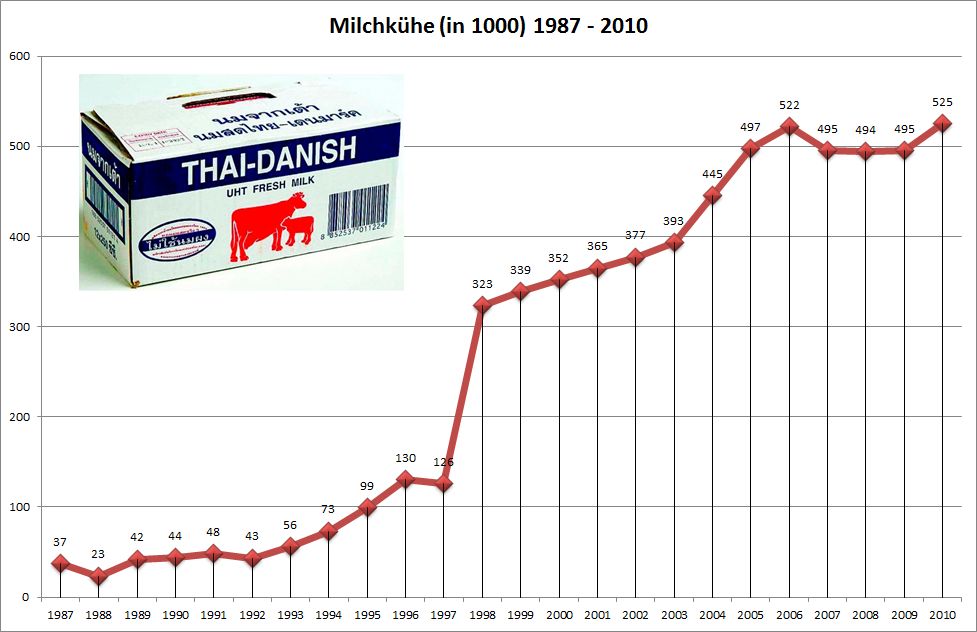
Abb.:
Milchkühe (in Tausend) 1987 - 2010
[Datenquelle: Thailand in figures 2012-2013. -- Vol. 1. -- ISBN
978-616-7256-11-9. -- S. 428]
1998
Eröffnung des Chiang Rai International Airport (ท่าอากาศยานนานาชาติแม่ฟ้าหลวงเชียงราย)
Abb.: Lage des Chiang Rai International Airport (ท่าอากาศยานนานาชาติแม่ฟ้าหลวงเชียงราย)
[Bildquelle: CIA. -- Public domain]
1998
Start der Planungen zum East-West Economic Corridor (EWEC) - Route 9 von Mawlamyaing (မော်လမြိုင်မြို့ = Moulmein, Myanmar) durch Thailand und Südlaos nach Danang (Đà Nẵng, Vietnam).
Abb.: Geplante GMS-Korridore
[Bildquelle: http://www.osmnorth-n2.moi.go.th/images/map/map_02.jpg. -- Zugriff am 2012-02-22. -- Fair use]
1995 - 2011

Außenhandel mit Deutschland:
Abb.: Außenhandel mit Deutschland 1995 - 2011
[Datenquelle: Bank of Thailand]
1998 - 2001

Hermann Erath (1945 - ) ist deutscher Botschafter in Thailand.
1998
Schwere Dengue-Epidemie: 130.000 diagnostizierte Fälle.
Abb.: Stegomyia aegypti, Überträger des Dengue-Fiebers
[Bildquelle: Wellcome Images. -- Creative Commons Lizenz (Namensnennung, keine kommerzielle Nutzung, keine Bearbeitung)]
1998
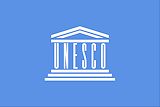
Start des UNESCO-Projects "A place for indigenous people in protected areas, Surin Islands, Andaman Sea, Thailand" zum Erhalt der Lebenswelt der seenomadischen Moken (มอเกน) auf den Surin Islands (หมู่เกาะสุรินทร์) in der Andamanensee (ทะเลอันดามัน).
Abb.: Lage der Surin Islands (หมู่เกาะสุรินทร์)
[Bildquelle: OpenStreetMap. -- Creative Commons Lizenz (Namensnennung, share alike)]
Abb.: Boot der Moken, Surin Islands (หมู่เกาะสุรินทร์)
[Bildquelle: Ronnakorn Potisuwan / Wikipedia. -- GNU FDLicense]
1998
Der Thailand Research Fund (สำนักงานกองทุนสนับสนุนการวิจัย) gibt eine Liste heraus mit den 100 Werken aus der Zeit von 1865 bis 1976, die ein Thai lesen sollte:
ประเภทบันเทิงคดี (FICTION)
ก. กวีนิพนธ์และบทละคร [Versdichtung und Schauspiele]
- ประชุมโคลงโลกนิติ [Khlong Lokaniti] / สมเด็จพระเจ้าบรมวงศ์เธอ กรมพระยาเดชาดิศร [Dechadison, 1793 - 1859]
- เสภาศรีธนญไชยเชียงเมี่ยง [Sepa: Der herrliche Sieg über Chiang Miang]
- นิราศหนองคาย [Nirat (Reisegedicht) Nong Khai] / หลวงพัฒนพงศ์ภักดี
- สามัคคีเภทคำฉันท์ [Die zerbrochene Eintracht - in Chan-Versen] / ชิต บุรทัต [Chit Burathat, 1892 - 1942]
- มัทนะพาธา [Die Tötung Mathanas - über die Entstehung der Rose, 1923] / พระบาทสมเด็จพระมงกุฏเกล้าเจ้าอยู่หัว [Vajiravudh / Rama VI., 1880 - 1925]
- โคลงกลอนของครูเทพ [Khlong Klon von Khru Deb] / เจ้าพระยาธรรมศักดิ์มนตรี [= สนั่น เทพหัสดิน ณ อยุธยา aka. ครูเทพ ; Chaophraya Thammasakmontri aka Khru Deb, 1876 - 1943]
- บทละครเรื่องพระลอ [Die Geschichte von König Phra Lo - ein Schauspiel] / พระเจ้าบรมวงศ์เธอ กรมพระนราธิปประพันธ์พงศ์ [Naradhip Prapanpongse, 1861 - 1931]
- ขอบฟ้าขลิบทอง [Der goldene Horizont] / อุชเชนี [= ประคิณ ชุมสาย ณ อยุธยา aka นิด นรารักษ์ ; Prakhin Xumsai Na Ayudhya, 1919 - ]
- เราชะนะแล้ว, แม่จ๋า / นายผี [= อัศนี พลจันทร ; Nai Phi = Atsani Phonlajan, 1918 - 1987]
- บทกวีของ [Gedichte] / เปลื้อง วรรณศรี [Pleuang Wannasri, 1922 - 1996]
- บทกวีของจิตร ภูมิศักดิ์ [Gedichte von Chit Phumisak] / จิตร ภูมิศักดิ์ [Chit Phumisak, 1930 - 1966]
- จงเป็นอาทิตย์เมื่ออุทัย / ทวีปวร [= ทวีป วรดิลก ; Thaweep Voradiloke 1928 - 2005]
- กวีนิพนธ์ [Gedichtsammlung] / อังคาร กัลยาณพงศ์ [Angkarn Kalayanapong, 1926 - 2012]
- ขอบกรุง [Stadtrand] / ราช รังรอง [= รัตนะ ยาวะประภาษ ; Raj Rangrong, 1928 - 1991]
- เพียงความเคลื่อนไหว / เนาวรัตน์ พงษ์ไพบูลย์ [Naowarat Pongpaiboon, 1940 - ]
ข. นิยาย [Romane]
- ละครแห่งชีวิต [The circus of life] / ม.จ. อากาศดำเกิง รพีพัฒน์ [Arkartdamkeung Rapheephat, 1905 - 1931]
- กามนิต [Kamanita] / เสฐียรโกเศศ, นาคะประทีป [Phra Sanprasert, 1889 - 1945]
- ดำรงประเทศ / เวทางค์ [= ทองอิน บุณยเสนา ; Thongin Bunyasena, 1908 - 1979]
- ผู้ชนะสิบทิศ [Der Besieger aller zehn Himmelsrichtungen] / ยาขอบ [= โชติ แพร่พันธุ์ ; Yakhob = Chot Phraephan, 1907 - 1956]
- หนึ่งในร้อย [Ein Prozent] / ดอกไม้สด [= หม่อมหลวงบุปผา กุญชร ; Dok Mai Sot = Buppha Kunchon, 1905 - 1963]
- บางระจัน [Bang Rajan] / ไม้ เมืองเดิม [Mai Muengderm, 1905 - 1942]
- หญิงคนชั่ว [Die Prostituierte] / ก. สุรางคนางค์ [= กัณ หา เคียงศิริ ; K. Surangkhanang = Kanha Kiengsiri, 1911 - 1999]
- พล นิกร กิมหงวน [1939 - 1968] / ป. อินทรปาลิต [= ปรีชา อินทรปาลิต ; Por Intharapalit = Preecha Intharapalit, 1910 -1968]
- ปักกิ่ง-นครแห่งความหลัง [Peking, Stadt der Erinnerungen] / สด กูรมะโรหิต [Sot Kumararohit, 1908 - 1978]
- เราลิขิต-บทหลุมศพวาสิฏฐี / ร.จันทพิมพะ [= เริ่ม จันทพิมพะ ; 1909 - 1954]
- เมืองนิมิตร / ม.ร.ว.นิมิตรมงคล นวรัตน์ [1908 - 1948]
- แม่สายสะอื้น / อ. ไชยวรศิลป์ [= อำพัน ไชยวรศิลป์ ; Amphan Chaiworasin 1908 - 1990]
- พัทยา [Pattaya] / ดาวหาง
- แผ่นดินนี้ของใคร [Wem gehört dieses Land?] / ศรีรัตน์ สถาปนวัฒน์ [1918 - 1975]
- มหาบัณฑิตแห่งมิถิลานคร [Der große Gelehrte der Stadt Mithila] / แย้ม ประพัฒน์ทอง [Yaem Praphatthong, 1910 - 1985]
- ปีศาจ [Pisaca-Dämon] / เสนีย์ เสาวพงศ์ [= ศักดิชัย บำรุงพงศ์ ; Sakchai Bumrungpong, 1918 - 2014]
- สี่แผ่นดิน [Vier Herrschaften, 1953] / ม.ร.ว. คึกฤทธิ์ ปราโมช [Kukrit Pramoj, 1911 - 1995]
- ทุ่งมหาราช [The field of the great] / มาลัย ชูพินิจ [Malai Choophinit, 1906 - 1963]
- แลไปข้างหน้า [Looking Ahead] / ศรีบูรพา [= กุหลาบ สายประดิษฐ์ ; Siburapha = Kulap Saipradit, 1905 - 1974]
- เสเพลบอยชาวไร่ / รงค์ วงษ์สวรรค์ [= ณรงค์ วงษ์สวรรค์ ; Rong Wongsawan = Narong Wongsawan 1932 - 2009]
- จดหมายจากเมืองไทย [Briefe aus Thailand] / โบตั๋น [= สุภา สิริสิงห ; Botan 1945 - ]
- เขาชื่อกานต์ [Er heißt Kan] / สุวรรณี สุคนธา [=สุวรรณี สุคนธ์เที่ยง ; Suwanni Sukhontha = Suwanni Sukhonthiang, 1932 - 1984]
- สร้างชีวิต [Aufbau eines Lebens] / หลวงวิจิตรวาทการ [Wichit Wichitwathakan, 1898 - 1962]
- ตะวันตกดิน [Sonnenuntergang] / กฤษณา อโศกสิน [= สุกัญญา ชลศึกษ์ ; กฤษณา อโศกสิน = Sukanya Cholasuk, 1931 - ]
- สร้อยทอง [Die goldene Halskette] / นิมิตร ภูมิถาวร [1935 - 1981]
- พิราบแดง [Die rote Taube] / สุวัฒน์ วรดิลก [Suwat Woradilok, 1923 - 2007]
- ลูกอีสาน [A child of the Northeast] / คำพูน บุญทวี [Kampoon Boontawee, 1928 - 2003]
ค. เรื่องสั้น [Kurzgeschichten]
- นิทานเวตาล [Die Erzählungen des Vetala] / น.ม.ส. [= พระราชวรวงศ์เธอ พระองค์เจ้ารัชนีแจ่มจรัส กรมหมื่นพิทยาลงกรณ์ ; N.M.S. = Phittayalongkorn, 1876 - 1945]
- จับตาย : รวมเรื่องเอก [Tot in die Hände des Verfolgers gefallen : gesammelte Meisterwerke] / มนัส จรรยงค์ [Manat Chanyong, 1907 - 1965]
- เรื่องสั้นของป. บูรณปกรณ์ [Kurzgeschichten] (ชีวิตจากมุมมืด, ดาวเงิน) / ป. บูรณปกรณ์ [= ปกรณ์ บูรณปกรณ์ ; P. Buranupakorn, 1904 - 1952]
- เสาชิงช้า [Die große Schaukel], เอแลนบารอง และเรื่องสั้นอื่นๆ ของ [Kurzgeschichten] / ส. ธรรมยศ [= แสน ธรรมยศ ; Saen Thammayos, 1914 - 1952]
- พลายมลิวัลลิ์ และเรื่องสั้นบางเรื่อง [Ein Elefant namens Maliwan und andere Kurzgeschichten] ของ / ถนอม มหาเปารยะ [Thanom Mahaphaoraya, 1908 - 1961]
- ผู้ดับดวงอาทิตย์ และเรื่องสั้นอื่นๆ [The man who put out the sun und andere Kurzgeschichten] / จันตรี ศิริบุญรอด [Juntree Siriboonrod, 1917 - 1968]
- ยุคทมิฬ และเรื่องสั้นอื่นๆ [Das grausame Zeitalter und andere Kurzgeschichten] ของ / อิศรา อมันตกุล [Isra Amantakul, 1921 - 1969]
- เรื่องสั้นชุดเหมืองแร่ [Gesammelte Bergbaugeschichten] / อาจินต์ ปัญจพรรค์ [Ajin Panjapan, 1927 - ]
- ฟ้าบ่กั้น [The Sky is No Barrier] / ลาว คำหอม [= คำสิงห์ ศรีนอก ; Lao Khamhawm = Khamsing Srinawk, 1930 - ]
- ชุดเพื่อนนักเรียนเก่า เพื่อนเก่า / เสนอ อินทรสุขศรี [Sanoe Intonsuksi, 1921 - 2014]
- รวมเรื่องสั้นบางเรื่องของฮิวเมอร์ริสต์ [Ausgewählte Kurzgeschichten] / ฮิวเมอร์ริสต์ [= อบ ไชยวสุ ; Humorist = Ob Chaiyavasu, 1901 - 1997]
- ฉันจึงมาหาความหมาย / วิทยากร เชียงกูล [1946 - ]
- คนบนต้นไม้ / นิคม รายวา [Nikom Rayawa, 1944 - ]
ประเภทสารคดี/บทความ (NON FICTION)
ก. ประวัติศาสตร์ [Geschichte]
- ประวัติกฎหมายไทย [Geschichte des Thai Rechts] / ร. แลงกาต์ [Robert Lingat, 1892 - 1972]
- นิทานโบราณคดี [Zur Archäologie] / สมเด็จฯ กรมพระยาดำรงราชานุภาพ [Damrong Rajanubhab, 1862 -1943]
- โฉมหน้าศักดินาไทย [The Real Face of Thai Feudalism, 1957] / จิตร ภูมิศักดิ์ [Chit Phumisak, 1930 - 1966]
- กบฏ ร.ศ. 130 / เหรียญ ศรีจันทร์, ร.ต.เนตร พูนวิวัฒน์
- เจ้าชีวิต [Lords of Life: the paternal monarchy of Bangkok, 1782–1932, 1960] / พระเจ้าวรวงศ์เธอ พระองค์เจ้าจุลจักรพงษ์ [Chula Chakrabongse, 1908 - 1963]
- ศาลไทยในอดีต [Das Gericht Thailands in der Vergangenheit] / ประยุทธ สิทธิพันธ์ [Prayut Sitthiphan]
- ประวัติศาสตร์ไทยสมัย 2352-2453 ด้านสังคม [Sozialgeschichte Thailands 1809 bis 1910] / ชัย เรืองศิลป์ [Chai Ruangsin, 1904 - 1975]
- สังคมไทยในสมัยต้นรัตนโกสินทร์ 2325 - 2416 [Die Gesellschaft Thailands in der frühen Rattanakosin-Periode 1782 bis 1873] / ม.ร.ว. อคิน รพีพัฒน์ [Akin Rabibhadana, 1933 - ]
ข. การเมือง,ประวัติศาสตร์ร่วมสมัย, เศรษฐศาสตร์ [Politik, Zeitgeschichte, Wirtschaft]
- ทรัพยศาสตร์ [Wissenschaft vom Wohlstand] / พระยาสุริยานุวัตร [(เกิด บุนนาค) ; Phraya Suryanuwat (Koet Bunnag), 1862 - 1936]
- เบื้องหลังการปฏิวัติ 2475 [Hintergrund der Revolution 1932] / กุหลาบ สายประดิษฐ์ [Kulap Saipradit, 1905 - 1974]
- ความเป็นอนิจจังของสังคม [Die Unbeständigkeit der Gesellschaft] / ปรีดี พนมยงค์ [Pridi Panomyong, 1900 - 1983]
- ท่านปรีดี รัฐบุรุษอาวุโส ผู้วางแผนเศรษฐกิจไทยคนแรก [Pridi, der ehrwürdige Staatsmann, der erste Wirtsachftsplaner Thailands] / เดือน บุนนาค [Duan Bunnag, 1905 - 1982]
- โอ้ว่าอาณาประชาราษฎร / สนิท เจริญรัฐ [Sanit Charoenrat]
- ไทยกับสงครามโลกครั้งที่สอง [Thailand and World War II] / ดิเรก ชัยนาม [Direk Jayanama, 1905 - 1967]
- สันติประชาธรรม / ป๋วย อึ๊งภากรณ์ [Puey Ungphakorn, 1916 - 1999]
- ห้าปีปริทัศน์ / ส. ศิวรักษ์ [สุลักษณ์ ศิวรักษ์ ; Sulak Sivaraksa, 1933 - ]
- วันมหาปิติ” วารสาร อมธ.ฉบับพิเศษ 14 ตุลาคม 2516 [Ein Tag großer Freude, Zeitschrift der Thammasat University Student Union, Sonderausgabe - 1973-10-14] / องค์การบริหารกิจกรรมนักศึกษา มหาวิทยาลัยธรรมศาสตร์ [Thammasat University Student Union]
ค. ศิลปะ ภาษาและวรรณกรรม วรรณกรรมวิจารณ์ [Kunst, Sprache und Literatur, Literaturwissenschaft]
- วรรณคดี และวรรณคดีวิจารณ์ [Literatur und Literaturwissenschaft] / วิทย์ ศิวะศิริยานนท์ [Wit Siwasiriyanon, 1914 - 1990]
- ประติมากรรมไทย [Thai Sculpture] / ศิลป พีระศรี [Silpa Bhirasri = Corrado Feroci, 1892 - 1962]
- วรรณสาส์นสำนึก / สุภา ศิริมานนท์ [Supha Sirimanond, 1914 - 1986]
- วิทยาวรรณกรรม [Literaturgeschichte] / พระเจ้าวรวงศ์เธอ กรมหมื่นนราธิปพงศ์ประพันธ์ [Wan Waithyakon. Kromamun Naradhip Bongsprabandh, 1891 - 1976]
- ความงามของศิลปไทย / น. ณ ปากน้ำ
- ภาษากฎหมายไทย [Die Rechtsprache Thailands] / ธานินทร์ กรัยวิเชียร [Thanin Kraivichien, 1927 - ]
- วรรณไวทยากร ชุมนุมบทความทางวิชาการ ฉบับวรรณคดี [Wan Waithayakon - gesammelte wissenschaftliche Aufsätze zur Literaturgeschichte] / เจตนา นาควัชระ [Chetana Nagavajara, 1937 - ] และ มล. บุญเหลือ เทพยสุวรรณ [Boonlua Thephayasuwan, 1911 - 1981]
- แสงอรุณ 2 [Saengarun 2] / แสงอรุณ รัตกสิกร [Saengarun Ratkasikorn, 1922 - 1979]
ง. สังคมวิทยา, มานุษยวิทยา, ประวัติศาสตร์สังคม [Soziologie, Anthropologie, Sozialgeschichte]
- พระราชพิธีสิบสองเดือน [Die königlichen Zeremonien im Lauf der zwölf Monate, 1888] / พระบาทสมเด็จพระจุลจอมเกล้าเจ้าอยู่หัว [Chulalongkorn / Rama V., 1853 - 1910]
- สาส์นสมเด็จ / สมเด็จฯ กรมพระยาดำรงราชานุภาพ [Damrong Rajanubhab, 1862 - 1943] และ สมเด็จเจ้าฟ้าฯ กรมพระยานริศรานุวัดติวงศ์ [Narisara Nuwattiwong, 1863 - 1947]
- 30 ชาติในเชียงราย [30 Nationen in Chiang Rai] / บุญช่วย ศรีสวัสดิ์ [Bunchai Srisawat, 1917 - 1973]
- เทียนวรรณ [Thianwan] / สงบ สุริยินทร์
- กาเลหม่านไต / บรรจบ พันธุเมธา [Banchop Phanthumetha, 1920 - 1992]
- นิทานชาวไร่ [Erzählung über die Trockenreisbauern] / น.อ. สวัสดิ์ จันทนี [Sawat Chanthani, 1902 - 1968]
- ภารตวิทยา [Indologie] / กรุณา-เรืองอุไร กุศลาสัย [Karuna Kusiralai, 1920 - 2009]
- ฟื้นความหลัง [Einnerungen] / พระยาอนุมานราชธน [Phya Anuman Rajadhon, 1888 - 1969]
- ความเป็นมาของคำสยาม ไทย, ลาว และขอม และลักษณะทางสังคมของชื่อชนชาติ [Etymologie der Bezeichnungen Siam, Thai, Lao und Khom sowie die gesellschaftlichen Eigenschaften der Ethnonyme, postum 1976] / จิตร ภูมิศักดิ์ [Chit Phumisak, 1930 - 1966]
- อัตชีวประวัติ หม่อมศรีพรหมา กฤดากร [Autobiographie] / หม่อมศรีพรหมา กฤดากร [หม่อมศรีพรหมา กฤดากร ณ อยุธยา ; Brahma Kridakorn na Ayutthaya, 1888 - 1978]
- 80 ปีในชีวิตข้าพเจ้า [80 Jahre meines Lebens] / กาญจนาคพันธ์ [ขุนวิจิตรมาตรา (สง่า กาญจนาคพันธุ์) ; Khun Wichitmatra (Sanga Kanchanakphan), 1897 - 1980]
จ. ศาสนา, ปรัชญา [Religion, Philosophie]
- พระประวัติตรัสเล่า / สมเด็จพระมหาสมณเจ้า กรมพระยาวชิรญาณวโรรส [Vajirananavarorasa, 1860 - 1921]
- พระไตรปิฎก ฉบับสำหรับประชาชน [Das Tipitaka für das Volk] / สุชีพ ปุญญานุภาพ [Suchip Punyanuphap, 1917 - 2000]
- ปัญญาวิวัฒน์ [Entfaltung der Weisheit] / สมัคร บุราวาศ [Samak Burawas, 1916 - ]
- พุทธธรรม [Die Lehre Buddhas] / พระธรรมปิฎก [= พระพรหมคุณาภรณ์ (ประยุทธ์ ปยุตฺโต) ; Phra Dhammapitaka = Phra Bhramagunabhorn (Prayudh Payutto), 1938 - ]
- อิทัปปัจจยตา [Entstehung in Abbhängigkeit] / พุทธทาสภิกขุ [Buddhadasa Bhikkhu, 1906 - 1993]
ฉ. ธรรมชาติ, วิทยาศาสตร์ [Natur, Naturwissenschaft]
- หนังสือแสดงกิจจานุกิจ / เจ้าพระยาทิพากรวงษ์ [(ขำ บุนนาค) ; Chaophraya Thipphakorawong Mahakosathibodi (Kham Bunnag), 1813 - 1870]
- แพทยศาสตร์สงเคราะห์ [Hilfe zur Medizin] / คณะกรรมการแพทย์หลวงในรัชกาลที่ 5 [Königliches medizinische Komitee des 5. Reichs]
- ธรรมชาตินานาสัตว์ [Naturkunde verschiedener Lebewesen] / บุญส่ง เลขะกุล [Boonsong Lekagul, 1907 - 1992]
- ขบวนการแก้จน / ประยูร จรรยาวงษ์ [Prayoon Chanyawongs, 1915 - 1992]
[Quelle: http://www.rsu.ac.th/soc/corner1.html. -- Zugriff am 2015-05-21]
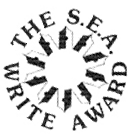
Raekham Pradouykham (= Suphan Thongklouy) (แรคำ ประโดยคำ = สุพรรณ ทองคล้อย, 1953 - ) erhält den Southeast Asian Writers Award für den Gedichtband ในเวลา
Abb.: Einbandtitel
1998
An einer Felswand bei Mae Mo (แม่เมาะ), Provinz Lampang (ลำปาง), werden prähistorische Felsmalereien entdeckt. Das Alter der ca. 1600 Bilder werden auf 3000 Jahre geschätzt. In der Nähe wurden Gräber gefunden.
Abb.: Lage von Mae Mo (แม่เมาะ)
[Bildquelle: OpenStreetMap. -- Creative Commons Lizenz (Namensnennung, share alike)]
1998
Kampagne der Society for the Prevention of Cruelty to Animals gegen die Euthanasie von streunenden Hunden in Bangkok: dies verstoße gegen buddhistische Prinzipien. Die Stadtverwaltung gibt unter dem Druck der Öffentlichkeit das Euthanasieprogramm für Hunde auf.
Abb.: Streunender Hund, Bangkok, 2009
[Bildquelle: Victor. -- http://www.flickr.com/photos/chibij/3292395480/. -- Zugriff am 2012-10-07. -- Creative Commons Lizenz (Namensnennung, keine kommerzielle Nutzung, keine Bearbeitung)]
"It is estimated that there are over 120,000 stray dogs in Bangkok, Thailand.[1][2] The management of "soi dogs" has become a serious problem in the capital. Status
Most of the 120,000 stray dogs in Bangkok are not aggressive, and many have been injured in traffic.[3] However, strays occasionally attack people, and few have been vaccinated against canine diseases.[2]
ManagementIn the 1990s, more than 200 dogs were euthanized each day. In 1998, however, the Society for the Prevention of Cruelty to Animals campaigned against the practice, which they argued violated Buddhist principles. The campaign generated substantial public outcry against the euthanization of dogs, and the city adopted a pro-life dog policy.
A recent regulation has forbidden the feeding of stray dogs in public places.[4]
In September 2007, the Bangkok Metropolitan Administration (กรุงเทพมหานคร)began a program of mandatory registration for dogs;[5] the program was aimed to deter the abandonment of dogs, which could be traced to their owners.[2] Requirements for such registration include the implantation of a microchip identifying the owner, rabies vaccination for dogs less than one year old, and sterilization;[6] dog owners were required to register their pets before July 2008.[5] Starting on July 4, 2008, dogs found unregistered may be sent to a dog kennel in the northern province of Uthai Thani (อุทัยธานี) and their owners may be fined up to 5,000 baht.[5] Critics of mandatory registration have asserted that it has actually increased the number of strays, as dog owners who do not wish to pay for implementation are abandoning their pets rather than risking receiving fines.[4]
Before prominent events, stray dogs have been rounded up and sent to shelters. This occurred before the 2003 Asia-Pacific Economic Cooperation, when thousands of dogs were removed from the city and sent to the Livestock Development Department's animal quarantine stations in Phetchaburi (เพชรบุรี) and Sa Kaeo (สระแก้ว) provinces.[1][3] Stray dogs were again transported from the city in preparation for the king's 2006 anniversary celebration, with efforts focusing on areas near expensive hotels where royal guests stayed.[7] These strays were sent to the kennel in Uthai Thani, where it was planned they would stay until their death.[7]
In popular cultureThe 2006 Thai movie Kao Niew Moo Ping by Siwaporn Pongsuwan focused on the relationship between a runaway girl and the stray dog she befriends."
[Quelle: http://en.wikipedia.org/wiki/Stray_dogs_in_Bangkok. -- Zugriff am 2012-10-097]
1998
In der Zeitschrift Nursingconnections erscheint der Artikel: Factors associated with penile amputation in Thailand / von G. A. Bechtel und C. M. Tiller über drei Ehefrauen in Südthailand, die ihren Männern aus Rache den Penis abgeschnitten haben.
1998
Erstausgabe der Zeitung เมืองอีสาน (Isaan-Land). Finanziert wird die Zeitung von der New Aspiration Party (NAP, พรรคความหวังใหม่) von General Chavalit Yongchaiyudh (พลเอก ดร.ชวลิต ยงใจยุทธ, 1932 - ). Die Zeitung findet keine große Verbreitung.
Der Herausgeber Thittikorn Thetsrimuang (ฐิติกรณ์ เทศศรีเมือง) schreibt:
"[T]he paper was bom from the initiatives of northeastern journalists "... and] wants to make northeastern people proud of their region and help them come together to have more political bargaining power. Now, we’re supporting NAP because we see it as the party with policies that would help the northeastern people." [Zitiert in: Genders & sexualities in modern Thailand / edited by Peter A. Jackson [1955 - ] & Nerida M. Cook. -- Chiang Mai : Silkworm, 1999. -- 289 p. ; 23 cm. -- ISBN 9747551071. -- S. 25.]
1998

Es erscheint die erste Übersetzung des ganzen Neuen Testaments in der Sprache der Urak Lawoi (Bibelteile wurden schon 1976 veröffentlicht)
ซูรัจ ปือมือเลา : ซูรัจ นู บารู : บาซา อูรัก ลาโวจ. -- Bangkok : Thailand Bible Society, 1998. -- 671 S. : Ill. ; 21 cm. -- ISBN 9748959619. -- In Thai-Schrift
Abb.: Lebensraum der Urak Lawoi
[Bildquelle: https://joshuaproject.net/people_groups/15722/TH. -- Zugriff am 2016-05-31. -- Fair use]
"Die Urak Lawoi (Thai: อูรักลาโว้ย) sind ein indigenes Volk in Thailand, das auf Inseln der Andamanensee lebt: Phuket (เกาะภูเก็ต), Siray (เกาะสิเหร่), Phi Phi (หมู่เกาะพีพี), Lanta (เกาะลันตา), Muk (เกาะมุก) und Bulon (เกาะบุโหลน), sowie im Tarutao-Nationalpark (อุทยานแห่งชาติตะรุเตา) auf Lipe (เกาะหลีเป๊ะ) und Adang (เกาะอาดัง). Ihm gehören etwa 6.000 Personen an. Die Urak Lawoi unterscheiden sich schon im Phänotyp, z. B. durch ihre dunklere Hautfarbe und die meist lockigen Haare, deutlich von den ethnischen Thais." [Quelle: https://de.wikipedia.org/wiki/Urak_Lawoi. -- Zugriff am 2016-05-31]
1998
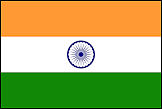
Es erscheint der von Bollywood inspirieret Song:
มนต์สิทธิ์ คำสร้อย [Monsit Khamsoi] <1964 - >: โกสัมพี [Kosambi]
Der Song auf Spotify:
URI: spotify:track:03IRivsJj74moDBdC1ineu
URL: https://open.spotify.com/track/03IRivsJj74moDBdC1ineu
Abb.: Kassettenhülle
[Fair use]
ca. 1998
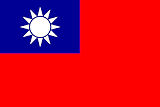
Es erscheint der Song
คณะนกยูงทอง [Khana Nok Yung Thong]: สาวไต้หวัน : ลำนิทานวรรณคดี โบราณ ["Fräulein Taiwan : ein erzählendes Lam der alten Literatur"].
ca. 1998
Es erscheint der Song
ลูกแพร อุไรพร ; ไหมไทย อุไรพร [Lukphrae und Maithai Uraiphon <1968 - >]: คิดถึงบ้าน ["Heimweh"].
Künstlerlink ลูกแพร อุไรพร auf Spotify:
URI: spotify:artist:1CBYVA0Bai0Knqy3VEVcmc
URL: https://open.spotify.com/artist/1CBYVA0Bai0Knqy3VEVcmc
ca. 1998
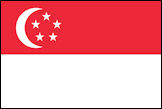
Es erscheinen auf Audiokassette der Song
เทพพร เพชรอุบล [Thepphon Phet-Ubon] <1947 - 2013>: บายศรีแรงงานไทยไปสิงคโปร์ ["Eine Baci-Zeremonie für Arbeiter, die nach Singapur gehen"]
Abb.: Thepphon Phet-Ubon [เทพพร เพชรอุบล]
[Bildquelle: Tpb kk / th.Wikipedia. -- Creative Commons Lizenz (Namensnennung, share alike)]
"Baci (Lao: ບາສີ; Thai: บายศรี, RTGS: bai si) and su kwan (Lao: ສູ່ຂວັນ; Thai: สู่ขวัญ, RTGS: su khwan; meaning "calling of the soul") is an important ceremony practiced in Lao culture[1][2][3] and Northern and Isan Thai culture. Baci is a phi ritual used to celebrate important events and occasions, like births and marriages and also entering the monkhood, departing, returning, beginning a new year, and welcoming or bidding etc. The ritual of the baci involves tying strings around a person’s wrist to preserve good luck, and has become a national custom."
[Quelle: http://en.wikipedia.org/wiki/Baci. -- Zugriff am 2014-09-08]
1998
Der Pop-Sänger Tai Thanwut (ไท ธนาวุฒิ, 1969 - ) veröffentlicht den Song ประเทือง. Darin spottet er über einen Kathoey (กะเทย, Transsexuellen) namens Pratheuang (ประเทือง). Der Song wird ein Hit. ประเทือง wird zu einem Synonym für Kathoey. Kathoeys empfinden diesen Ausdruck als respektlos.
Der Song auf Spotify:
URI: spotify:track:1GpgawcUIrHDv4eoz5Q5EK
URL: https://open.spotify.com/track/1GpgawcUIrHDv4eoz5Q5EK
Abb.: CD-Cover
1998

Es erscheint:
Southeast Asia / Terry E. Miller and Sean Williams, ed. -- New York : Garland, 1998. --1024 S. : Ill. ; 29 cm. -- (The Garland encyclopedia of world music ; v. 4). -- ISBN 0824060407
Abb.: Einbandtitel
1998

Es erscheint:
Lockard, Craig A. <1942 - >: Dance of life : popular music and politics in Southeast Asia. -- Honolulu : University of Hawaiì Press, 1998. -- 390 S : Ill. -- ISBN 9780585277042
Abb.: EinbandtitelDer Autor - Professor of History, Social Change and Development, University of Wisconsin, Green Bay - gibt Luk Thung (เพลงลูกทุ่ง), "the siren songs of extensively promoted pop music", die Schuld dafür, dass "authentische" Thai Volksmusik und klassische Musik verschwinden.
1998
Es erscheint die Sammlung von Kurzgeschichten
ประชาคม ลุนาชัย [Prachakhom Lunachai] <1959 - >: ตัวละครตกสมัย ["Ein Charakter, der aus der Zeit fällt"]
Die Titelgeschichte ist in Technik und Inhalt ein Meilenstein der Thai-Literatur.
Abb.: Einbandtitel
1998

In einer Zeitschrift erscheint die Kurzgeschichte
ไชยา วรรณศรี [Chaya Wannasri]: เสียงกลอง ["Klang der Trommel"]
Darin schildert der Autor, wie seine Begeisterung für Mönche schwindet, als er in seine Heimat Nordostthailand zurückkehrt und entdeckt, dass sich der Tempel völlig geändert hat und der Abt Sex hat.
1998

Ab jetzt können Kandidaten für den Eintritt in den buddhistischen Mönchsorden einem Urintest und anderen Drogentests unterzogen werden. Fallen diese Tests positiv aus, wird der Eintritt in den Orden verweigert.
1998
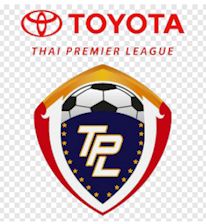
Sieger in der Thai Premier League (ไทยพรีเมียร์ลีก) (Fußball): Sinthana (สินธนา)
Abb.: ®Logo
[Bildquelle: Wikipedia]
1998
Briefmarken:
ausführlich: http://www.payer.de/thailandchronik/ressourcen.htm
Zu Chronik 1998 / B. E. 2541. -- 2. Januar bis Juni